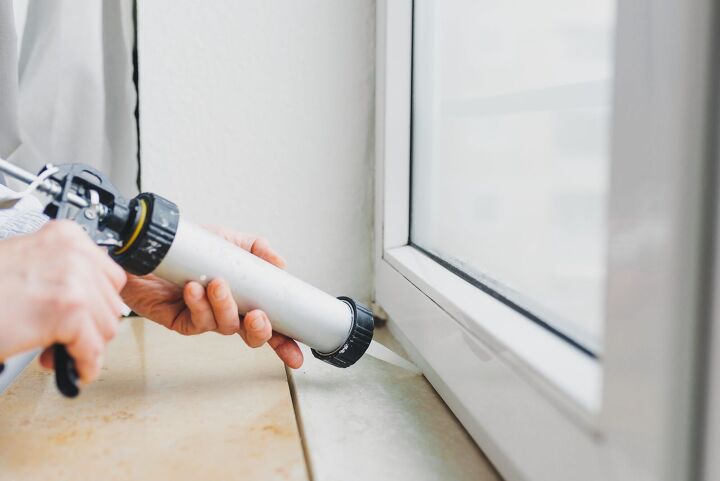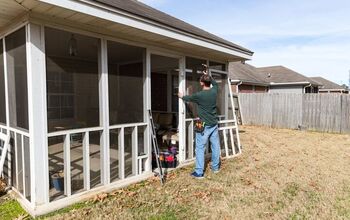How Often Should I Caulk My Windows?

Having your own home is everyone’s dream; however, many overlook the upkeep. Sure, you might have to do some remodeling and rearranging to make it feel fit. However, one thing that many people forget is caulking the windows. But how often should they do this?
You should caulk your windows as much as they need it. Over time, caulk tends to deteriorate, causing cold or warm drafts and water to make their way in. Furthermore, your home can lose its curb appeal. So, re-caulk as much as it seems fit.
Below we will discuss the importance of caulking your windows and how often you should do it. This way, you can keep your home in tip-top shape. Let’s get started!
Why Should You Caulk Your Windows?
Caulk is used by painters mainly for your windows to look better overall. It would be unprofessional and unattractive to leave gaps around the window pane and sills.
So, before painting, caulk is used to fill the gaps. And in case you’re wondering, there are caulk varieties that work well with paint.
People who work in building maintenance, those who specialize in home remodeling, and homeowners themselves turn to caulk for safety. They are aware that caulking is a preventative measure that can shield a home from dreaded problems like mildew, wood rot, and masonry fractures from seriously harming the building.
All of these are caused by water leaking into a crack or opening around the window, which then ruins the nearby flooring and/or walls.
What Are The Benefits of Caulking?
When you consider the numerous advantages it offers, taking the time to carefully choose the right composition caulk and apply it, is worth every second it takes to check each window for gaps.
Your Energy Bill Will Be Lower
It’s the same as leaving a window open a crack if there are gaps around it. Now, in the winter, you might believe it’s letting chilly air in, but that would be incorrect according to the law of thermodynamics.
The heat is moving, and it is leaving your house because heat flows from hotter locations to cooler ones. Another myth that needs to be dispelled while we’re doing this is the idea that it always rises. Yes, it rises upward, but it also decreases in pressure.
Therefore, if the hot air inside your home perceives an opportunity to escape through a gap that requires caulking when your furnace is running in the winter, it will do so.
Eventually, the temperature inside your home will drop one, two, or three degrees. When the thermostat eventually detects it, the heater will turn back on.
In contrast, the air conditioner will work hard during the summer to reach the desired temperature because the hot air will find its way into your chilled home. However, when the caulk is used to fill the gaps around the windows, warm air stays warm and chilly air stays cool, depending on your preference.
Caulking Gives Your Windows A Waterproof Seal
Many building materials are not water-resistant when utilized to build a house. This is particularly true if drywall panels were used to create the walls and wood was used for the structure.
When you think about it, this makes most suburban and rural homes, especially older ones, prone to leaks. Around the windows, unsealed spaces or even little fractures act as invitations for rain and melting snow.
Leaks could be moving down within the walls, along the frame, and toward the underfloor, where the water will not only soak the wood but also rot it away. This could be happening without you even realizing it.
Caulking Windows Keeps Insects At Bay
If you create a path through a crack or gap surrounding your window frame—especially if it’s warm and dry or chilly and dry—you’re inviting insects in since they can fit through small openings.
You won’t need to use poisonous sprays or insecticidal powders because sealing the space will keep them out.
Curb Appeal Is Increased With Window Caulking
No matter how minor, gaps and cracks around windows or deteriorating caulk can give your home a worn-out, neglected appearance. This is not what you want at any time, let alone when your house is on the market.
You might not necessarily need new windows as a result. A fresh coat of caulk may fix these flaws and give your home a polished appearance, particularly if you use colored sealant.
How Often Should You Caulk Around Your House?
In a brand new home, you could be caulking around your house within the year! This is because the caulking’s integrity appears to suffer during the first year when the house appears to settle.
Therefore, if the initial caulk is loose and no longer effectively seals the window, trim, and exterior, checking all the windows and recaulking them is the best course of action.
How frequently you’ll need to re-caulk an older home depends on the caulk’s quality when it was previously applied. On average, caulk ought to last five years, but that doesn’t mean you shouldn’t check it every year or two.
If you’ve noticed drafts or a sudden increase in energy costs, that’s one indication that you could need to caulk once more.
What Can Happen if You Don’t Caulk Your Windows As Often As You Should?
In addition to the effects already mentioned, such as structural deterioration, mold growth, increased energy costs, and a shabby appearance, failing to maintain your windows’ caulking can have many more negative effects.
You Will Have More Work To Do
The need for new caulk won’t go away, just like any chore you could complete today but postponed until the proverbial tomorrow.
In a sense, Mother Nature will fulfill her end of the contract. Whether it’s the sun drying out the caulk or the rain finding a way in, the weather will continue to have an impact.
As a result, when you finally get down to caulking the windows, you might find that you have more work than you anticipated. Additionally, it can end up costing you extra if you’re not the DIY kind.
Your Window Panes Will Loosen
Since caulk acts as a cushion between the window and the frame, it can cause loose, rattling glass if it is missing or weakened.
Never ignore loose window panes, since a strong wind or shoving the window shut may cause the glass to shatter, harming a family member or breaking furniture or other belongings.
Water Can Get In
If the caulk around the exterior of the window is damaged, water may seep into the plaster or drywall and cause the paint on the interior and outside of the house to bubble and peel.
Should a major storm occur, when the wind may force the rain into the smallest of openings, the problem will be made worse.
What Happens If You Don’t Caulk Windows?
When window seals are damaged or torn away, windows leak. This occurs as a result of the caulk’s expiration date or prolonged exposure to the elements.
The air inside your home can then escape due to leaks. Additionally, rain and drafts might enter your house through cracks.
How Much Does It Cost To Re-Caulk Windows?
Re-caulking a property typically costs between $3 and $6 per linear foot. This often adds up to anywhere from $900 to $2,700 for a medium-sized home.
This is an average price, and before a precise price can be offered, a number of factors must be taken into account.
What Type of Caulking is Best for Windows?
One of the best caulks for sealing windows is silicone caulk. With its flexible composition, silicone helps create a durable seal that can be applied to interior or exterior windows and will not crack in extreme heat or cold. Due to these qualities, it excels as a flexible exterior caulk.
Do I Need To Hire A Professional To Caulk My Windows?
You do not need to hire a professional to caulk your windows, as this is something that is easily done on your own. Not to mention, caulking your windows yourself will save you a lot of money.
You will only need to purchase the material if you decided to do it DIY. This can save you hundreds, if not thousands of dollars, depending on the size of your home.
If you are uncomfortable doing this on your own, you can always ask a family member or a friend to do it for you. This will still cost less than hiring a professional, as some professionals will charge you a high per-hour rate or a high flat rate.
If you decide to hire help, take a moment to watch what they do so that you can learn how to do it on your own. You will most likely be re-caulking your windows once a year. As mentioned before, doing this on your own will save you a ton of money.
Wrapping It Up
You need to re-caulk your windows however often they need it done! This is to help keep water and insects out while keeping your ideal temperatures in!
By doing this on your own, you can save a fair amount of money as you will not be paying for labor. All you have to pay for is the cost of materials, and you’re good to go!
Related Guides:

Heather is a passionate writer who loves anything DIY. Growing up, she learned everything from home repairs to design, and wants to share her tips with you. When she's not writing, she's usually hiking or searching for her next DIY project.
More by Heather Robbins



























